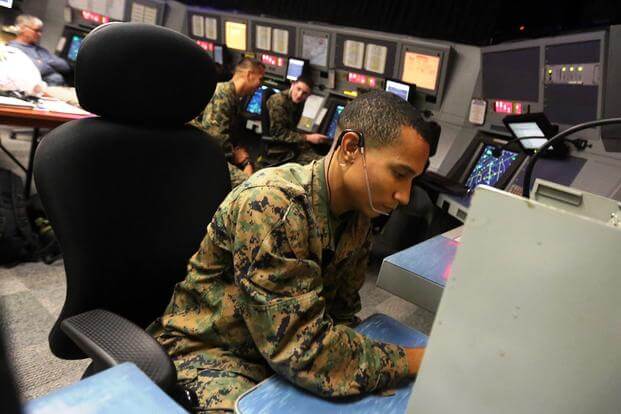It could have been the start of a nightmare scenario.
Between 4 p.m. and 5 p.m. on a rainy night last December, Cpl. Justin McDaniel, an air traffic controller at Marine Corps Air Station Cherry Point, North Carolina, was about two hours into his 8-1/2-hour shift.
The rhythm of his typical work of monitoring aircraft on final approach to the airfield was fractured when a gunnery sergeant approached his work station with news about a crisis: A Marine AV-8B Harrier pilot with 2nd Marine Aircraft Wing, who had been flying close to the base for practice, had suddenly lost his entire heads-up display.
While such a malfunction would ordinarily be cause for concern, the weather conditions turned the issue into a life-or-death emergency. With heavy rain falling and a dense cloud cover obscuring the ground at a low altitude of 440 feet, the pilot had been relying entirely on aircraft controls as he flew. All of a sudden, the controls were gone and he was lost in the clouds.
"You can barely see three miles ahead of you," McDaniel said. "It's like driving blindfolded; that's the best way I can put it."
The outage, the cause of which remains unclear, also affected the aircraft's gyroscopic instruments, making the jet more difficult to control manually.
McDaniel, 22, had been an air traffic controller for about four years, but had never encountered a crisis like this one. He had little time for panic.
"You hear ‘an emergency' and your blood starts to flow," he said. "All you can do as an air traffic controller is take your adrenaline turn it back to your job. The pilot's life is in your hands."
When McDaniel was first informed about the display malfunction, the pilot was in a descent at 4,000 feet. McDaniel took over when he was fewer than 1,600 feet off the ground. On the first attempt at guided descent the pilot was still in shock at the loss of instruments and was hesitant to take instructions, McDaniel said. But on a second attempt, the controller and pilot worked together like a machine.
McDaniel had to give the pilot step-by-step directions, dictating left and right turns against a stiff wind that sometimes made it difficult to keep the aircraft on course.
The three or four minutes it took to guide the pilot down out of the cloud cover felt like a much longer stretch of time. As the Harrier finally broke through the clouds, the pilot was rewarded with a welcome sight.
"All he could see was the center line of the runway between his legs," McDaniel said. "When he first landed, our tower controllers, they just told us the pilot made it safely on deck; there was no issues. I mean, all we knew was we made it safe on deck, we did our jobs."
McDaniel was awarded the Navy and Marine Corps Achievement Medal on Dec. 3, two days after the incident, though his accomplishment was not publicized by the Marine Corps until this month.
In a rare turn of events, the pilot of the Harrier also made an appearance at McDaniel's medal ceremony, officials said, extending personal thanks to the Marine from himself and his wife for bringing him out of the clouds without incident.
"That was one of the biggest things I took away, knowing that I helped him," McDaniel said.
In coming months, McDaniel said he plans to conclude his active Marine Corps service and look for work as a civilian contractor in Afghanistan, where he can continue to use his ATC experience to guide American pilots to the ground safely.






























